2013 Yamaha Apex SE Review – Video

Power steering, four-cylinder engine and Fox Float shocks set Apex SE apart
We’d say that Yamaha Apex snowmobiles were misunderstood except that they aren’t. They simply appeal to a more discerning crowd, one that places a premium on the experience of snowmobiling and the quality of the ride. And they like a sled that stands out from the crowd or, at least, one that can get away from the crowd.
The 2013 Yamaha Apex SE stands out. Priced close to US$15,000 and more than $17,000 in Canadian dollars, the Apex SE separates serious buyers from bargain seekers in a hurry. But, the irony may be that the seemingly spendy Apex may well be the better long-term buy. Quality matters, but you do pay for it.
Get the Flash Player to see this player. |
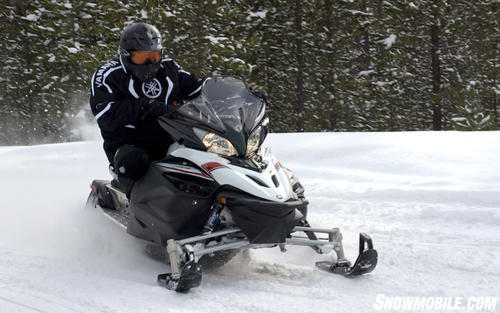 Yamaha’s power steering makes the Apex Se feel lighter in the corners.
Yamaha’s power steering makes the Apex Se feel lighter in the corners.
No other modern snowmobile comes with the under hood magic of an Apex. It has the most cylinders, four. Each cylinder uses three intake and two exhaust valves to manage the air-fuel mixture that is carefully calibrated by a very sophisticated electronic fuel injection system and EXUP (exhaust ultimate power valve) exhaust system. While total horsepower exceeds 150, that power is carefully manipulated by the intake and exhaust systems to provide maximum torque for exceptional low speed and midrange performance while ensuring high speed revs exceeding five digits. Fortunately you don’t need to think about any of this when you push in the throttle flipper, that’s the work of the onboard computer. All you’ll know and care about is that the system works very, very well.
Yamaha switched over to the EXUP system at the same time as it added electronic power steering (EPS). While you can have one without the other, as is the case with the Vector with EPS, the two pieces working together truly accentuate the snowmobiling experience on the Apex. The combination gives you an adept low speed casual trail cruiser when you get stuck in mid-pack on a club outing. When you are out riding with a few friends, the steering reverts to normal as speed and revs pick up. This all makes the 2013 Apex SE one of the most versatile performance-oriented snowmobiles on the market.
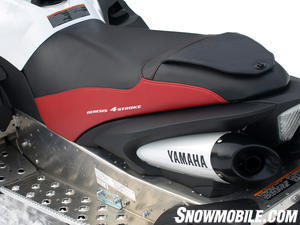 The Apex SE seat offers a sturdy platform and blends nicely rearward to the styled exhaust.
The Apex SE seat offers a sturdy platform and blends nicely rearward to the styled exhaust.
If you like technology, you’ll be able to brag up this sled. It can rev beyond 10 grand, but its Yamaha YXVC clutching set settles in happily at trail revs. You’ll note some of the Apex’ quality pluses in the magnesium chaincase cover, making it both lighter in weight and durable for the long time value. The engine comes with a high tech rumble at idle, which builds to a high-revving racing motorcycle type scream. Well, maybe not a scream, but a very attention-grabbing sound that comes as you open up the four 39mm Mikuni fuel injectors and the computerized EXUP kicks in to let the exhaust free up from the four headers to the dual tail pipes that are styled into the sled’s tail. There’s a lot of engineering thought that went into this sled.
Computer thinking on board makes riding this sled incredibly easy. The fuel injection computer reads and reacts to ambient temperature, barometric pressure and a myriad of other details. The EXUP opens and closes as an onboard computer circuit works with the engine’s module, which also supplies information to the power steering. Human engineering provides the baselines for the way the systems work together, but the onboard diagnostics define the second-to-second reactions to everything from throttle opening to how much steering input to give the steering and so on.
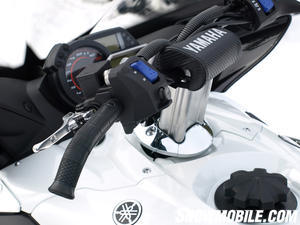 Heat carries all the way to the end of the curved handlebars, which aid performance riding.
Heat carries all the way to the end of the curved handlebars, which aid performance riding.
That being said, all a snowmobiler really cares about is what will the Apex do for me? It will get you to some speeds that could bring a hefty fine. It will put down power that will give you strong acceleration and a bit more as you cross over from double digits to a triple digit top end. At midrange or in tight, tiring trails you’ll be glad that the steering effort is light and agile. The Apex is not the lightest sled in the over 150 hp category. Yamaha’s unique-to-snowmobiling power steering pays for itself at the end of a tough weekend. It tends to make the sled feel much lighter than it really is. However, if you pound this sled mile after mile in brutal whoops, it will wear on you. That’s not the role of the Apex SE even if it has a premium Fox air shock package front and rear.
The price differential between a standard Apex and the 2013 Apex SE comes primarily from the shock packaging. The base Apex features aluminum-bodied high-pressure gas shocks to control the front end with a remotely adjusted gas shock on the rear suspension. The upgrade in the “SE” package revolves around the latest Fox Float shocks. Controlling the 8.6-inches of travel from the A-arm front end are Fox Float 2 “air” shocks, which you can set to very precisely establish handling and ride preferences. The shock on the Yamaha Mono Shock II Air rear suspension is also a Fox design, but this is the Mega Float. With a similar design as the front shocks, the Mega Float has more than twice the air volume of the base Float shock to dramatically reduce heat build up and also to provide a smoother stroke response for improved ride characteristics. If you were to buy a base Apex and then add the Mega Float setup, you’d be looking at US$800 alone. Add in a pair of Fox Float 2 for the front suspension and you can add US$700. As you can see, the SE pricing with the premium shocks is a relative bargain over doing it yourself.
If you check out the Apex versus the Apex SE, you’ll find that they compare closely. The SE value is in the shock packaging. The two Apex snowmobiles both claim the underhood attributes of unique four-cylinder engine and stout normally aspirated four-stroke performance. We especially like the frisky nature of this high revving quad. It reacts much like a two-cycle in that it’s in a hurry to reach revs; that comes from its Yamaha R1 race-bred street screamer motorcycle background. It takes a special gear reduction to get the happy revver Genesis powerplant to clutch-able limits, but Yamaha manages it well, not sacrificing the top end love that this engine brings to its rider. Even if you never discover this sled’s real top speed, you can enjoy powering through 12-inch snows watching the tachometer sail past conventional limits of other sled motors.
What the Yamaha Apex SE offers appeals to different aspects of why we ride, sometimes in the same day. We like the sound that the quad makes at idle. We like to hear it scream on a long straight. We appreciate the light and easy steering when we kick back and enjoy a favorite narrow local trail. We like the way the sled fits together and how it feels underneath us on a trail ride. And we enjoy knowing that this sled is different from the pack and if we want to hit the throttle hard, we can break free in an instant.
Oh, yes, we also like knowing that resale on a Yamaha Apex SE will be among the best in the sport. So, maybe, the time we have it to enjoy on the trails, combined with the residual value we’ll get back when we trade it in on its successor will make the 2013 Yamaha Apex SE a pretty good purchase overall. In the time we have it we can count on its keeping us out on the trail enjoying the sport. Just the way we like it.
| 2013 Yamaha Apex SE Specs | |
| Engine | Yamaha Genesis 150FI; 998cc, 4-cylinder, 4stroke, liquid-cooled; electronically controlled fuel injection; EXUP exhaust |
| Horsepower | 150-plus |
| Drive | Yamaha YVXC |
| Front Suspension | Yamaha short/long arm wishbone; 8.56-in travel; Fox Float 2 adjustable gas shocks |
| Rear Suspension | Yamaha Mono Shock II Air; 11.6-in travel; Fox Mega-Float adjustable shock |
| Length | 111.6 in |
| Height | 47.6 in |
| Width | 47.2 in |
| Ski Stance | 42.8 in |
| Track | 15 x 128 x 1.25 Rip Saw |
| Brake | Yamaha 4-piston hydraulic with ventilated disc and mechanical “parking” brake |
| Weight | N/A |
| Fuel Capacity | 9.4 US Gal (recommended premium unleaded) |
| Features | Electric power steering; reverse, electric fuel gauge, digital gauge, DC outlet |
| MSRP | $14,949 |
Related Reading
2012 Yamaha Apex Review
2011 Yamaha Apex SE Review
2012 Yamaha RS Vector EPS Review – Video
Yamaha Unveils Electronic Power Steering
Bassett’s Blog : Power Steering Coming Soon? (Nov. 2007)



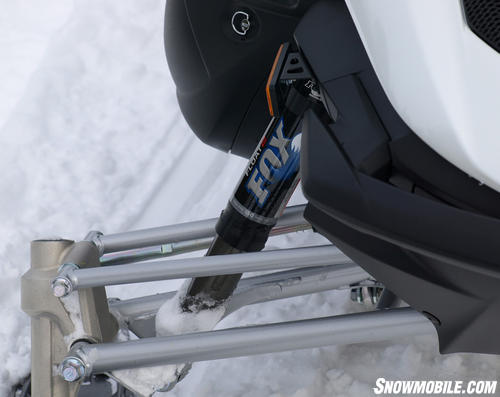
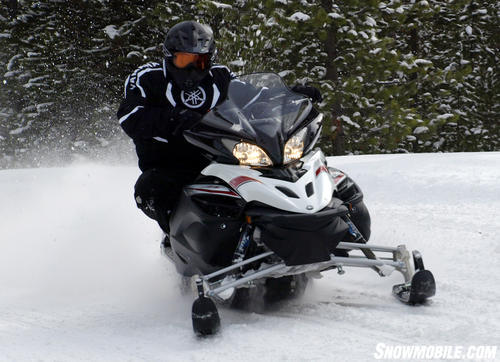





 Your Privacy Choices
Your Privacy Choices